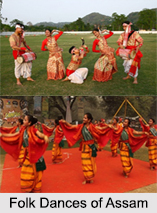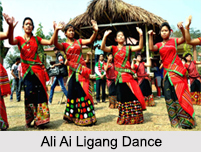 Folk Dances of Assam is the best expression of the traditions and custom of Assam. Assam is home to numerous groups and tribes like Mongoloid, Indo-Burmese, Indo-Iranian, Aryan, Rabha, Bodo, Kachari, Karbi, Mising, Sonowal Kacharis and Mishimi, which is why the state enjoys multiplicity at its best. Also, the influence of this variety can be seen in the ethnicity and traditions particularly in the dance and music of Assam.
Folk Dances of Assam is the best expression of the traditions and custom of Assam. Assam is home to numerous groups and tribes like Mongoloid, Indo-Burmese, Indo-Iranian, Aryan, Rabha, Bodo, Kachari, Karbi, Mising, Sonowal Kacharis and Mishimi, which is why the state enjoys multiplicity at its best. Also, the influence of this variety can be seen in the ethnicity and traditions particularly in the dance and music of Assam.
Various Folk Dance forms are prevalent in the different corners of Assam. The popular Folk Dances of Assam are as follows:
Bihu Dance
This is the most popular Folk Dances of Assam and as the very name recommends, is related to the Bihu celebration, which is celebrated with much splendour and glory throughout the state. Bihu dance is performed mostly during the period after the completion of crop. The festivities continue for a month. There are many modern forms of this dance.
Jhumair Nach
Jhumair Nach is one of the most significant Folk Dances of Assam performed by the tea workers of Assam. After a long day of work and hard labour, the tea workers or the tea tribes (also known as Adivasis) treat in dance and music to break the boredom of their life and to spread cheerfulness all through. The musical instrument used is something similar to that of a drum, called as Mandar.
 Bagurumba Dance
Bagurumba Dance
Bagurumba dance is performed by the Bodo society of Assam. This dance is also called the Butterfly Dance and Bardwishika dance. Bagurumba dance has comparatively slow steps with high formations that overwhelm the audience. This dance is performed in mid of April particularly during the season of Bishuba Sankranti. The formations done by the dancers contain butterfly and birds.
Ali Ai Ligang Dance
Ali Ai Ligang dance is highly admired amongst the Mishing community of Assam. Ali Ai Ligang is a celebration that is interlinked with agriculture and is celebrated during the Ahu paddy farming. They also perform this dance to praise their deity – the Mother Earth. The dance form expresses the ups and downs of man"s life and is aptly portrayed. The musical instruments used mainly are flutes, drums, gong and so on.
Deodhani Dance
Deodhani is one of the Folk Dances of Assam which is associated with the devotion of the snake goddess Manasa. This dance is performed by a girl who, in a trance-like inspired state, goes on dancing to the beats of the Ciphung (flute) and the Kham (drum). At one stage of the dance, she even takes a sword and a shield performing a war dance, honouring different Gods and Goddesses, like Shiva, Lakshmi, etc.
Bhortal Nritya
This form of dance is chiefly a spread of the Sankari culture of Assam and was originally developed by the well known Satriya artist, Narahari Burha Bhakat. During the festivals in the Barpeta and Guwahati regions, this dance is performed by a group of 6-10 dancers equipped with cymbals.
Khamba Lim
This is one of the Folk Dances of Assam which is performed by two groups of men and women, who stand in two rows.
Ankiya Nat
Ankiya Nat is a one-act play, initiated by Sankardeva. Srimanta Shankardeva composed various forms of literary kind of work like Bargeet, Ojha Pali songs and numerous dances, which were incorporated into the dance drama, termed as Ankiya Nat.



















